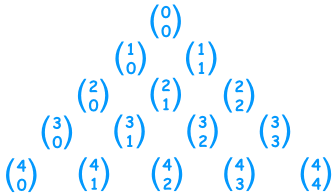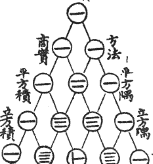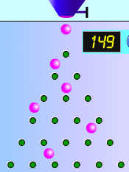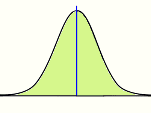Using Pascal's Triangle
Heads and Tails
Pascal's Triangle can show you how many ways heads and tails can combine. This can then show you "the odds" (or probability) of any combination.For example, if you toss a coin three times, there is only one combination that will give you three heads (HHH), but there are three that will give two heads and one tail (HHT, HTH, THH), also three that give one head and two tails (HTT, THT, TTH) and one for all Tails (TTT). This is the pattern "1,3,3,1" in Pascal's Triangle.
| Tosses | Possible Results (Grouped) | Pascal's Triangle |
|---|---|---|
| 1 | H T | 1, 1 |
| 2 | HH HT TH TT | 1, 2, 1 |
| 3 | HHH HHT, HTH, THH HTT, THT, TTH TTT | 1, 3, 3, 1 |
| 4 | HHHH HHHT, HHTH, HTHH, THHH HHTT, HTHT, HTTH, THHT, THTH, TTHH HTTT, THTT, TTHT, TTTH TTTT | 1, 4, 6, 4, 1 |
| ... etc ... |
Example: What is the probability of getting exactly two heads with 4 coin tosses?
There are 1+4+6+4+1 = 16 (or 24=16) possible results, and 6 of them give exactly two heads. So the probability is 6/16, or 37.5%Combinations
The triangle also shows you how many Combinations of objects are possible.Example: You have 16 pool balls. How many different ways could you choose just 3 of them (ignoring the order that you select them)?
Answer: go down to row 16 (the top row is 0), and then along 3 places and the value there is your answer, 560.Here is an extract at row 16:
1 14 91 364 ... 1 15 105 455 1365 ... 1 16 120 560 1820 4368 ...
A Formula for Any Entry in The Triangle
In fact there is a formula from Combinations for working out the value at any place in Pascal's triangle:| It is commonly called "n choose k" and written like this: |  |
 | The "!" is "factorial" and means to multiply a series of descending natural numbers. Examples:
|
| So Pascal's Triangle could also be an "n choose k" triangle like this: (Note that the top row is row zero) |  |
Example: Row 4, term 2 in Pascal's Triangle is "6" ...
... let's see if the formula works:
Polynomials
Pascal's Triangle can also show you the coefficients in binomial expansion:| Power | Binomial Expansion | Pascal's Triangle |
|---|---|---|
| 2 | (x + 1)2 = 1x2 + 2x + 1 | 1, 2, 1 |
| 3 | (x + 1)3 = 1x3 + 3x2 + 3x + 1 | 1, 3, 3, 1 |
| 4 | (x + 1)4 = 1x4 + 4x3 + 6x2 + 4x + 1 | 1, 4, 6, 4, 1 |
| ... etc ... |
The First 15 Lines
For reference, I have included row 0 to 14 of Pascal's Triangle1
1 1
1 2 1
1 3 3 1
1 4 6 4 1
1 5 10 10 5 1
1 6 15 20 15 6 1
1 7 21 35 35 21 7 1
1 8 28 56 70 56 28 8 1
1 9 36 84 126 126 84 36 9 1
1 10 45 120 210 252 210 120 45 10 1
1 11 55 165 330 462 462 330 165 55 11 1
1 12 66 220 495 792 924 792 495 220 66 12 1
1 13 78 286 715 1287 1716 1716 1287 715 286 78 13 1
1 14 91 364 1001 2002 3003 3432 3003 2002 1001 364 91 14 1 | The Chinese Knew About ItThis drawing is entitled "The Old Method Chart of the Seven Multiplying Squares". View Full ImageIt is from the front of Chu Shi-Chieh's book "Ssu Yuan Yü Chien" (Precious Mirror of the Four Elements), written in AD 1303 (over 700 years ago, and more than 300 years before Pascal!), and in the book it says the triangle was known about more than two centuries before that. |
The Quincunx
 | An amazing little machine created by Sir Francis Galton is a Pascal's Triangle made out of pegs. It is called The Quincunx. Balls are dropped onto the first peg and then bounce down to the bottom of the triangle where they collect in little bins.
|

Tidak ada komentar:
Posting Komentar